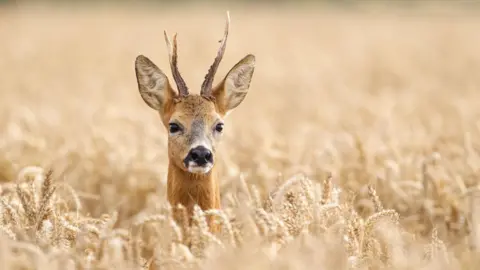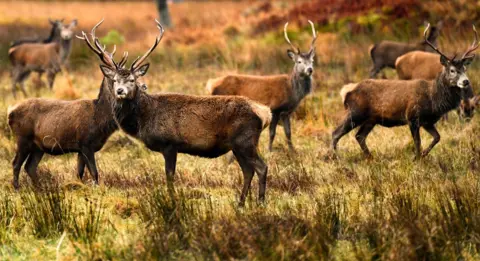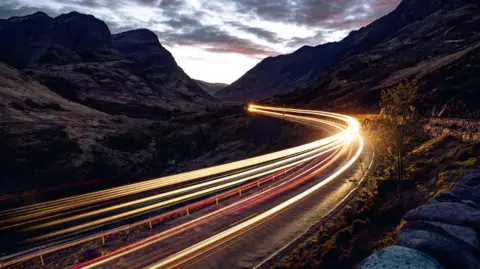Where are you at most risk of hitting a deer in Scotland?
 Getty Images
Getty ImagesAn estimated 1,850 collisions involving traffic and deer have occurred every year in Scotland since 2016.
New analysis published by NatureScot looks at where and why the accidents happen, places with the highest risks - and possible solutions.
How many deer are there in Scotland?
 Getty Images
Getty ImagesScotland has four species of deer.
Red and roe are native, while fallow are descendants of deer brought over from continental Europe in the 11th Century.
Sika arrived in Scotland more than 100 years ago after they were introduced to the UK from Asia.
Muntjac, another non-native species, have also been spotted in parts of Scotland.
Scotland has about one million wild deer - about 500,00 more than in 1990, according to the Scottish government.
NatureScot, Scotland's nature body, said deer-vehicle collisions have been on the increase.
It said this was due to rising traffic volumes and the increased range of deer over the past 20 years.
When do collisions happen?
 Getty Images
Getty ImagesThey can happen at any time of the year.
But NatureScot said the highest risk months were May and June.
This is when young deer are on the move looking for their own territories.
The peak time for collisions is dusk, though the risk is higher during winter when there are more hours of darkness.
Collisions often result in the deaths of deer, but there have also been human fatalities.
Three fatal incidents were recorded between 2018 and 2021 - one in the Highlands in 2018, one in Aberdeenshire in 2019 and one in South Lanarkshire in 2020.
For the UK, it has been estimated that more than £17m is spent every year on vehicle repairs because of deer collisions.
Where are places with the highest risks?
The highest number of collisions occur in the Highlands, according to figures released in 2023.
Between 2008 and 2021 there were 555 incidents involving vehicles and deer on Highland roads.
Argyll and Bute has the second highest figure - 369 - followed by Dumfries and Galloway with 161.
But problems have also been identified in parts of central Scotland.
In the new report, M9 Pirnhall interchange near Stirling, M8 Livingston interchange and A82 Renton junction near Dumbarton are described as "hotspots".
The collisions involve roe deer.
The interchanges have large "islands" of overgrown vegetation favoured by the deer but rarely visited by people - and surrounded on all sides by busy roads.
NatureScot's study said incidents peaked every five to seven years after deer populations recovered from collisions.
It said at the M8 Livingston interchange there was a large rise during 2020, followed by two years of lower incidents before rising again in 2023.
Can accidents be prevented?
NatureScot has been working with Transport Scotland, Bear Scotland and Amey South West Trunk Roads to look at potential ways to reduce collisions.
They include removing scrub and other overgrown vegetation from road verges.
Also, fencing at the worst affected areas.
Road animal detection systems (RADS) could also be installed.
They are activated when they detect the movement of deer and forewarn drivers the animals are near.
